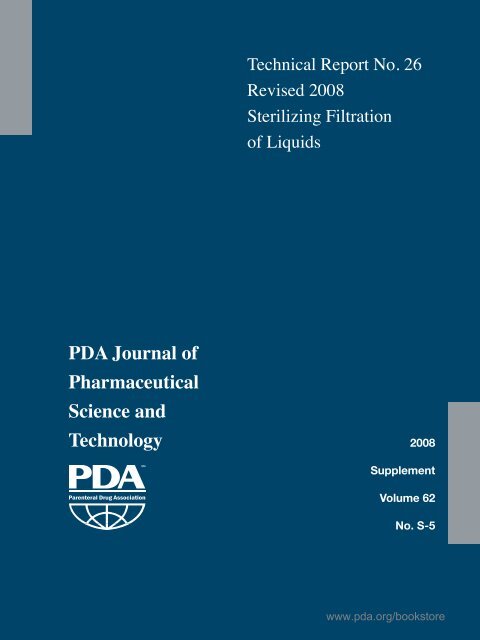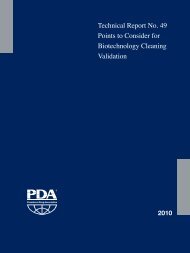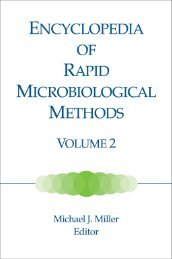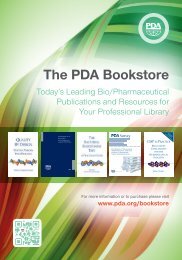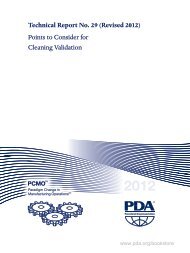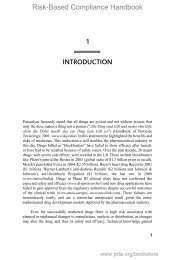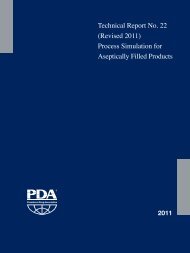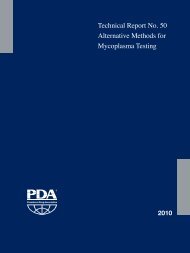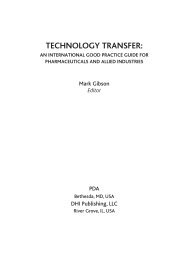PDA Journal of Pharmaceutical Science and ... - store.pda.org
PDA Journal of Pharmaceutical Science and ... - store.pda.org
PDA Journal of Pharmaceutical Science and ... - store.pda.org
Create successful ePaper yourself
Turn your PDF publications into a flip-book with our unique Google optimized e-Paper software.
Technical Report No. 26<br />
Revised 2008<br />
Sterilizing Filtration<br />
<strong>of</strong> Liquids<br />
<strong>PDA</strong> <strong>Journal</strong> <strong>of</strong><br />
<strong>Pharmaceutical</strong><br />
<strong>Science</strong> <strong>and</strong><br />
Technology 2008<br />
Supplement<br />
Volume 62<br />
No. S-5<br />
www.<strong>pda</strong>.<strong>org</strong>/book<strong>store</strong>
Sterilizing Filtration <strong>of</strong> Liquids Task Force<br />
Hanna R. Kviat Antonsen, Novo Nordisk A/S<br />
Victor Awafo, PhD, San<strong>of</strong>i Pasteur<br />
Mrs. Jean L. Bender, Genentech, Inc.<br />
Jeffrey R. Carter PhD, GE Healthcare<br />
Robert S. Conway, PhD, Consultant<br />
Stefan Egli, Pall Corporation.<br />
Teresa M. Feeser, PhD, Bristol-Myers Squibb Company<br />
Maik W. Jornitz, Sartorius Stedim Biotech S.A.<br />
Mary Kearns, Schering-Plough Corporation<br />
Richard V. Levy, PhD, <strong>PDA</strong><br />
Russell E. Madsen, The Williamsburg Group, LLC<br />
Jerold M. Martin, Pall Corporation<br />
Leesa D. McBurnie, Meissner Filtration Products, Inc.<br />
Laura S. Meissner, Meissner Filtration Products, Inc.<br />
Theodore H. Meltzer, PhD, Capitola Consulting Company<br />
Vinayak Pawar, PhD, U.S. Food <strong>and</strong> Drug Administration<br />
Maurice Phelan, Millipore Corporation<br />
Paul S. Stinavage, PhD, Pfizer Inc<br />
Neal Sweeney, PhD, U.S. Food <strong>and</strong> Drug Administration<br />
Humberto Vega, PhD, Merck & Co., Inc.<br />
Leonore C. Witchey-Lakshmanan, PhD, GeneraMedix, Inc.<br />
The content <strong>and</strong> views expressed in this technical report are the result <strong>of</strong> a consensus achieved by the authoring<br />
task force <strong>and</strong> are not necessarily views <strong>of</strong> the <strong>org</strong>anizations they represent.<br />
www.<strong>pda</strong>.<strong>org</strong>/book<strong>store</strong>
Sterilizing Filtration<br />
<strong>of</strong> Liquids<br />
Technical Report No. 26 (Revised 2008)<br />
Supplement to the<br />
<strong>PDA</strong> <strong>Journal</strong> <strong>of</strong> <strong>Pharmaceutical</strong><br />
<strong>Science</strong> <strong>and</strong> Technology<br />
Vol 62, No. S-5<br />
2008<br />
© 2008 <strong>PDA</strong><br />
www.<strong>pda</strong>.<strong>org</strong>/book<strong>store</strong>
Table <strong>of</strong> Contents<br />
1.0 Introduction....................................................2<br />
1.1 Purpose/Scope.................................................2<br />
2.0 Glossary OF TERMS..........................................3<br />
3.0 HOW FILTERS WORK............................................7<br />
3.1 Pore Size Rating...............................................7<br />
4.0 FILTER SELECTION AND CHARACTERIZATION...8<br />
4.1 Filter Qualification <strong>and</strong> Validation.....................8<br />
4.1.1 Revalidation..............................................9<br />
4.2 Filter Cleanliness..............................................9<br />
4.3 Filter Safety....................................................10<br />
4.3.1 Toxicity....................................................10<br />
4.3.2 Animal-Derived Materials........................10<br />
4.4 Operational Ranges........................................10<br />
4.5 Filter Interactions with the Process Stream..... 10<br />
4.5.1 Evaluating Filter Extractables <strong>and</strong><br />
Leachables..............................................10<br />
4.5.2 Chemical Compatibility...........................12<br />
4.5.3 Adsorption..............................................12<br />
5.0 Filter Use, H<strong>and</strong>ling <strong>and</strong> Design<br />
Considerations..............................................13<br />
5.1 Flow Characteristics.........................................13<br />
5.2 Filter Throughput...............................................14<br />
5.3 Filter Scale-up Considerations..........................15<br />
5.3.1 Small-Scale Device Testing.......................16<br />
5.3.2 Filter Cartridge Design...............................16<br />
5.4 Effect <strong>of</strong> System Design...................................17<br />
5.5 Operating Conditions........................................18<br />
5.5.1 Inlet <strong>and</strong> Differential Pressure....................18<br />
5.5.2. Filtration Process Temperature..................18<br />
5.5.3 Filtration Time (Duration)...........................19<br />
5.5.4 Flushing Conditions / Filter Priming...........19<br />
6.0 STERILIZING FILTER VALIDATION/<br />
BACTERIAL RETENTION.....................................20<br />
6.1 Factors Influencing Bacterial Retention..........20<br />
6.2 Bacterial Retention Validation Studies..............20<br />
6.3 Bacterial Retention Validation Studies –<br />
Risk Assessment...........................................21<br />
6.4 Challenge Organism Selection Criteria...........22<br />
6.5 Culture Maintenance <strong>and</strong> Challenge<br />
Preparation.....................................................22<br />
6.6 Testing Procedure <strong>and</strong> Protocol Development...23<br />
6.7 Nonbactericidal Processes <strong>and</strong> Fluids............23<br />
6.8 Bacteriostatic/Bactericidal/Nondispersive<br />
Challenge Fluids.............................................23<br />
6.8.1 Reduced Exposure Time..........................25<br />
6.8.2 Modify Test Method Parameters.............25<br />
6.8.3 Modify Test Product Formulation............25<br />
6.8.4 Use <strong>of</strong> Resistant Indigenous Bioburden.....25<br />
6.9 Filtrate Sampling............................................26<br />
6.10 Results Interpretation.....................................26<br />
6.11 Filters in Series..............................................26<br />
6.12 Filter Assembly Change.................................26<br />
7.0 INTEGRITY TESTING............................................27<br />
7.1 Relationship between Integrity Test Results<br />
<strong>and</strong> Bacterial Retention..................................28<br />
7.1.1 Validation Testing....................................29<br />
7.1.2 Integrity Testing <strong>of</strong> Production Filters......30<br />
7.1.3 Filtrate Sterility Assurance......................30<br />
7.2 Product-Wetted Integrity Tests......................30<br />
7.2.1 Product-Wetted Bubble Point Tests.........30<br />
7.2.1.1 Bubble Point Ratio Approach...........30<br />
7.2.1.2 Bubble Point Statistical Approach...31<br />
7.2.2 Product-Wetted Diffusive/Forward-Flow<br />
Test.........................................................32<br />
7.3 Automated Integrity Test Instruments............32<br />
7.4 Integrity Testing <strong>of</strong> Filters in Large,<br />
Multiple-Cartridge Housings..........................33<br />
7.5 Qualification <strong>of</strong> Integrity Test Devices............33<br />
www.<strong>pda</strong>.<strong>org</strong>/book<strong>store</strong>
Table <strong>of</strong> Contents<br />
7.6 When a Sterilizing-Grade Filter Should be<br />
Integrity Tested..............................................34<br />
7.6.1 Pre-Use Integrity Test Considerations.....35<br />
7.6.2 Post-Filtration Integrity Test<br />
Considerations........................................36<br />
7.6.3 Serial Filtration........................................36<br />
7.7 Failure Analysis/Troubleshooting....................36<br />
7.7.1 Insufficient Wetting Failure Analysis.......39<br />
8.0 STERILIZATION OF FILTERS...............................40<br />
8.1 Steam Sterilization.........................................40<br />
8.1.1 Autoclave................................................40<br />
8.1.2 Steam in Place........................................41<br />
8.2 Irradiation Sterilization...................................41<br />
8.3 Gas Sterilization.............................................41<br />
8.4 Resterilization <strong>of</strong> Filters..................................42<br />
9.0 SINGLE-USE DISPOSABLE SYSTEMS................43<br />
9.1 Filter Capsules...............................................43<br />
9.2 User Requirement Specifications...................43<br />
9.3 Component <strong>and</strong> System Qualification............44<br />
9.3.1 Qualification Tests...................................44<br />
9.3.2 Process <strong>and</strong> Functionality Tests..............44<br />
10.0 APPENDICES.......................................................46<br />
Appendix A: Diffusive Flow Theory......................46<br />
Appendix B: Nondestructive Physical Integrity<br />
Test Methods...................................48<br />
Appendix C: Statistical Adjustment To The<br />
Calculated Product-Wetted<br />
Bubble Point....................................55<br />
Appendix D: Integrity Test Troubleshooting Guide...56<br />
11.0 REFERENCES.......................................................58<br />
www.<strong>pda</strong>.<strong>org</strong>/book<strong>store</strong>
1.0 Introduction<br />
Sterilizing filtration is the process <strong>of</strong> removing micro<strong>org</strong>anisms* from a fluid stream without adversely<br />
affecting product quality. (1–4) This technical report is intended to provide a systematic approach to<br />
selecting <strong>and</strong> validating the most appropriate filter for liquid-sterilizing filtration applications.<br />
<strong>PDA</strong>’s original Technical Report No. 26, Sterilizing Filtration <strong>of</strong> Liquids, published in 1998, described<br />
the use <strong>and</strong> validation <strong>of</strong> sterilizing filtration to a generation <strong>of</strong> pharmaceutical scientists <strong>and</strong> engineers.<br />
This revision <strong>of</strong> the original report was developed in response to enhancements in filtration<br />
technologies <strong>and</strong> recent additional regulatory requirements within the pharmaceutical industry.<br />
References to regulatory documents, st<strong>and</strong>ards <strong>and</strong> scientific publications are provided where more<br />
detail <strong>and</strong> supportive data may be found.<br />
When membrane filters entered the market in the 1960s, 0.45 µm-rated membranes were considered<br />
“sterilizing-grade” filters <strong>and</strong> were used successfully in the sterilizing filtration <strong>of</strong> parenterals. These<br />
filters were qualified using Serratia marcescens as a st<strong>and</strong>ard bacterium for qualifying membranes<br />
used for water quality testing. In a paper published in 1960, however, Dr. Frances Bowman <strong>of</strong> the U.S.<br />
Food <strong>and</strong> Drug Administration observed a 0.45 µm “sterile-filtered” culture medium to be contaminated<br />
with an <strong>org</strong>anism subsequently shown to repeatedly penetrate 0.45 µm-rated membranes in<br />
small numbers at challenge levels above 10 4 -10 6 per cm². (5) This led to the development <strong>of</strong> ASTM F<br />
838, a st<strong>and</strong>ard test method for evaluating sterilizing-grade membrane filters. (6) Challenge <strong>org</strong>anisms<br />
are discussed further in Section 6.4.<br />
1.1 Purpose/Scope<br />
The primary objective <strong>of</strong> the task force has been to develop a scientific technical report on sterilizing<br />
filtration. The report does not always address region-specific regulatory expectations, but provides<br />
up-to-date scientific recommendations for use by industry <strong>and</strong> regulators in establishing a sterilizing<br />
filtration policy. This report should be considered a guide <strong>and</strong> is not intended to establish m<strong>and</strong>atory<br />
st<strong>and</strong>ards for sterilizing filtration. Concepts presented in this report pertain to processes in which<br />
sterilizing-grade filter performance is necessary <strong>and</strong> may not be universally applicable to all filtration<br />
processes (e.g., early stage filtration or routine bioburden). These include, but are not limited to, cell<br />
culture media, buffer, intermediate holds in aseptic process, bulk <strong>and</strong> final sterile filling.<br />
The task force was composed <strong>of</strong> European <strong>and</strong> North American industry <strong>and</strong> regulatory pr<strong>of</strong>essionals<br />
to provide a diverse perspective, thus ensuring that the methods, terminology <strong>and</strong> practices <strong>of</strong><br />
sterilizing filtration presented are reflective <strong>of</strong> sound science <strong>and</strong> can be utilized globally. This report<br />
underwent an 11-week global technical peer review that included feedback from the Americas, Asia-<br />
Pacific <strong>and</strong> Europe.<br />
*Note: Sterilizing filtration is not intended to remove viruses.<br />
2<br />
www.<strong>pda</strong>.<strong>org</strong>/book<strong>store</strong><br />
<strong>PDA</strong> <strong>Journal</strong> <strong>of</strong> <strong>Pharmaceutical</strong> <strong>Science</strong> <strong>and</strong> Technology Vol. 62 • No. S-5 • 2008
2.0 Glossary <strong>of</strong> Terms<br />
For the purposes <strong>of</strong> this technical report, the following terms are used <strong>and</strong> are accompanied by their<br />
synonyms, where applicable.<br />
Adsorption<br />
The retention <strong>of</strong> solutes, suspended colloidal<br />
particles or micro<strong>org</strong>anisms to fluid contact<br />
surfaces, e.g., the surfaces <strong>of</strong> pores in filtration<br />
membranes.<br />
Aseptic<br />
Free from disease-producing micro<strong>org</strong>anisms.<br />
An operation performed in a controlled environment<br />
designed to prevent contamination<br />
through the introduction <strong>of</strong> micro<strong>org</strong>anisms.<br />
Assay<br />
Analytical method used to determine the purity<br />
or concentration <strong>of</strong> a specific substance in a<br />
mixture.<br />
Bacteria<br />
Single-celled, microscopic <strong>org</strong>anisms typically<br />
with a cell wall <strong>and</strong> characteristic shape (e.g.,<br />
round, rod-like, spiral or filamentous); lacking<br />
a defined nucleus (“prokaryotic”).<br />
Bioburden<br />
A population <strong>of</strong> viable micro<strong>org</strong>anisms in a<br />
fluid prior to sterilizing filtration. (7)<br />
Bracketing Approach<br />
A validation method that tests the extremes<br />
<strong>of</strong> a process or product. The method assumes<br />
the extremes will be representative <strong>of</strong> all the<br />
samples between the extremes. [Synonym:<br />
matrix validation.]<br />
Bubble Point<br />
The measured differential gas pressure at which<br />
a wetting liquid (e.g., water, alcohol, product)<br />
is pushed out <strong>of</strong> the largest pores <strong>of</strong> a wetted<br />
porous membrane <strong>and</strong> a steady stream <strong>of</strong> gas<br />
bubbles or bulk gas flow is detected. [Synonym:<br />
transition point.]<br />
Bubble Point Test<br />
A test to indicate the maximum pore size <strong>of</strong> a<br />
filter. The differential gas pressure at which a<br />
liquid (usually water) is pushed out <strong>of</strong> the largest<br />
pores <strong>and</strong> a steady stream <strong>of</strong> gas bubbles is<br />
detected from a previously wetted filter under<br />
specific test conditions. Used to test filter integrity<br />
with specific, validated, pressure values,<br />
wetting liquids <strong>and</strong> temperatures for specific<br />
pore-size (<strong>and</strong> type <strong>of</strong> ) filters.<br />
Cake<br />
Solids deposited on the upstream side <strong>of</strong> filter<br />
media.<br />
Capsule Filter<br />
A self-contained filter device or assembly.<br />
Cartridge Filter<br />
A filter device requiring a housing for use.<br />
Compatibility<br />
Pro<strong>of</strong> that no adverse interaction between the<br />
filter <strong>and</strong> the process fluid has occurred.<br />
Diffusive Flow<br />
The movement <strong>of</strong> a dissolved gas across a liquidwetted<br />
membrane based on the concentration<br />
(e.g., gas pressure) differential.<br />
Diffusive/Forward Flow Test<br />
A test to determine the integrity <strong>of</strong> a filter.<br />
[Synonym: diffusive flow test, forward flow<br />
test.]<br />
Direct Interception<br />
Particles with diameters larger than the filter<br />
pore diameter that are prevented from passing<br />
through the filter.<br />
Downstream Side (<strong>of</strong> a Filter)<br />
The filtrate or outlet side <strong>of</strong> the filter.<br />
Effective Filtration Area<br />
The total surface area <strong>of</strong> the filter available to<br />
the process fluid.<br />
Effluent<br />
Fluid that flows out <strong>of</strong> a process step.<br />
Endotoxin<br />
Lipopolysaccharides from the cell walls <strong>of</strong><br />
bacteria, the most potent <strong>of</strong> which derive from<br />
Gram-negative <strong>org</strong>anisms. When injected, they<br />
are known to cause a febrile, or fever-producing<br />
reaction that can cause severe patient reactions,<br />
<strong>and</strong> on occasion, can be fatal.<br />
www.<strong>pda</strong>.<strong>org</strong>/book<strong>store</strong><br />
Vol. 62 • No. S-5 • 2008 <strong>PDA</strong> <strong>Journal</strong> <strong>of</strong> <strong>Pharmaceutical</strong> <strong>Science</strong> <strong>and</strong> Technology 3
Extractable<br />
A chemical component that is removed from<br />
a material by the application <strong>of</strong> an artificial or<br />
exaggerated force (e.g., solvent, temperature or<br />
time).<br />
Filter (noun)<br />
A device used to remove particles from a fluid<br />
process stream that consists <strong>of</strong> a porous medium<br />
<strong>and</strong> a support structure.<br />
Porous material through which a liquid or gas<br />
is passed to remove viable <strong>and</strong> non-viable particles.<br />
(6)<br />
Filter (verb)<br />
To pass a fluid through a porous medium<br />
whereby bacteria or other particles are removed<br />
from the fluid.<br />
Filterability Test<br />
A test to determine the suitability <strong>and</strong> sizing <strong>of</strong><br />
a filter with a given fluid.<br />
Filter Efficiency<br />
A measurement <strong>of</strong> how well a filter retains<br />
particles. It is usually expressed as the percentage,<br />
or ratio, <strong>of</strong> the retention <strong>of</strong> particles <strong>of</strong> a<br />
specific size by a filter.<br />
Filter Element<br />
The basic filter unit from which cartridges or<br />
capsules are assembled.<br />
Filtrate<br />
Fluid that has passed through a filter.<br />
Filtration<br />
The process by which particles are removed<br />
from a fluid by passing the fluid through a<br />
porous material.<br />
Flow rate<br />
The volumetric rate <strong>of</strong> flow <strong>of</strong> a solution,<br />
expressed in units <strong>of</strong> volume per time (e.g., L/min<br />
or g/day).<br />
Flux<br />
The rate <strong>of</strong> filtrate flow divided by the<br />
membrane area.<br />
Fouling<br />
The result <strong>of</strong> solutes blinding or blocking<br />
membrane pores. It is observed as a decrease in<br />
the flux (at constant pressure) or an increase in the<br />
filtration differential pressure (at constant flux).<br />
Gamma Irradiation<br />
Ionizing radiation that can be used to sterilize<br />
a material.<br />
Gauge Pressure<br />
Gauge pressure is the difference between a given<br />
fluid pressure <strong>and</strong> that <strong>of</strong> the atmosphere.<br />
Hydrophilic<br />
Literally “water loving.” A filter that will wet<br />
with aqueous solutions to allow flow at a low<br />
pressure differential.<br />
Hydrophobic<br />
Literally “water fearing.” A filter that repels<br />
aqueous <strong>and</strong> other high-surface tension fluids<br />
<strong>and</strong> therefore cannot be wetted unless subjected<br />
to a high pressure differential. When prewetted<br />
with low surface tension fluid, such as alcohol,<br />
the membrane will allow water flow at a low<br />
pressure differential.<br />
Influent<br />
Fluid that flows into a process step. [Synonym:<br />
feed.]<br />
Integrity Test<br />
A nondestructive physical test that can be correlated<br />
to the bacterial retention capability <strong>of</strong> a<br />
filter/filter assembly. (6)<br />
Leachable<br />
A chemical component that migrates from a<br />
contact surface into a drug product or process<br />
fluid during storage or normal use conditions.<br />
Mass Spectroscopy<br />
An analytical test method for identifying the<br />
chemical composition <strong>of</strong> a sample by separating<br />
its gaseous component ions according to<br />
their mass <strong>and</strong> charge.<br />
Materials <strong>of</strong> Construction<br />
Polymers or other materials that make up the<br />
components <strong>of</strong> the filter.<br />
4<br />
www.<strong>pda</strong>.<strong>org</strong>/book<strong>store</strong><br />
<strong>PDA</strong> <strong>Journal</strong> <strong>of</strong> <strong>Pharmaceutical</strong> <strong>Science</strong> <strong>and</strong> Technology Vol. 62 • No. S-5 • 2008
Medium<br />
In filtration, the porous material which retains<br />
particles as a fluid passes through during the<br />
process <strong>of</strong> filtration<br />
Membrane<br />
A thin, microporous medium used to remove<br />
particles <strong>and</strong> micro<strong>org</strong>anisms from a fluid<br />
stream under pressure.<br />
Micro<strong>org</strong>anism<br />
A microbe; a free-living <strong>org</strong>anism too small to<br />
be seen by the naked eye.<br />
Module<br />
Filter element that is incorporated into a<br />
cartridge or capsule.<br />
Non-fiber Releasing<br />
Refers to a filter that does not shed fibers into<br />
the filtrate.<br />
Particle<br />
Any discrete unit <strong>of</strong> material structure; a<br />
discernible mass having an observable length,<br />
width, thickness, size <strong>and</strong> shape.<br />
Particulate<br />
Relating to, or occurring in the form <strong>of</strong>, particles.<br />
Permeability<br />
The degree to which a fluid will pass through a<br />
porous substance under specified pressure <strong>and</strong><br />
temperature conditions.<br />
Pore<br />
The channel(s)/path(s) in a membrane through<br />
which a fluid may pass.<br />
Porosity<br />
The ratio <strong>of</strong> void volume to bulk volume <strong>of</strong> the<br />
filter media.<br />
Pre-Filter<br />
Any filter placed upstream <strong>of</strong> the final filter.<br />
Pressure<br />
Force applied per unit area, usually expressed as<br />
psi, mbar, kPa or kg/cm 2 .<br />
Back Pressure<br />
Pressure applied downstream <strong>of</strong> a filter or<br />
other piece <strong>of</strong> equipment.<br />
Differential Pressure<br />
The difference in pressure between the<br />
upstream (feed or influent) <strong>and</strong> downstream<br />
(effluent) sides <strong>of</strong> the filter. (May be modified<br />
with the following terms: applied differential<br />
pressure, available differential pressure,<br />
clean differential pressure, dirty differential<br />
pressure, initial differential pressure or<br />
maximum differential pressure.) [Synonym:<br />
delta P (Δ P), psid or pressure drop]<br />
Inlet Pressure<br />
The applied pressure entering the upstream<br />
side <strong>of</strong> the filter. [Synonym: influent,<br />
upstream or line pressure]<br />
Outlet Pressure<br />
The pressure exiting the downstream side <strong>of</strong><br />
the filter. [Synonym: effluent or downstream<br />
pressure]<br />
Redundant Filtration<br />
A type <strong>of</strong> serial filtration in which a second<br />
sterilizing-grade filter is used as a backup in the<br />
event <strong>of</strong> an integrity failure <strong>of</strong> the primary sterilizing<br />
filter.<br />
Serial Filtration<br />
Filtration through two or more filters <strong>of</strong> the<br />
same or decreasing pore size, one after the<br />
other.<br />
Sterilization<br />
Validated process used to render a product free<br />
<strong>of</strong> viable micro<strong>org</strong>anisms.<br />
NOTE: In a sterilization process, microbiological<br />
death or reduction is described by an<br />
exponential function. Therefore, the number<br />
<strong>of</strong> micro<strong>org</strong>anisms that survive a sterilization<br />
process can be expressed in terms <strong>of</strong> probability.<br />
While the probability may be reduced to a very<br />
low number, it can never be reduced to zero.<br />
Sterilizing-Grade Filter<br />
A filter that reproducibly removes test micro<strong>org</strong>anisms<br />
from the process stream, producing a<br />
sterile filtrate.<br />
Surface Tension<br />
The tendency <strong>of</strong> the surface <strong>of</strong> a liquid to<br />
contract to the smallest area possible under<br />
defined conditions. It is expressed as dynes per<br />
centimeter.<br />
www.<strong>pda</strong>.<strong>org</strong>/book<strong>store</strong><br />
Vol. 62 • No. S-5 • 2008 <strong>PDA</strong> <strong>Journal</strong> <strong>of</strong> <strong>Pharmaceutical</strong> <strong>Science</strong> <strong>and</strong> Technology 5
Surfactant<br />
A soluble compound that reduces the surface<br />
tension <strong>of</strong> a liquid or reduces interfacial tension<br />
between two liquids (causing the formation <strong>of</strong><br />
micelles), or between a liquid <strong>and</strong> a solid.<br />
Throughput<br />
The amount <strong>of</strong> solution that passes through<br />
a filter. It is described as volume through the<br />
membrane area. [Synonym: capacity]<br />
Validation<br />
A documented program that provides a high<br />
degree <strong>of</strong> assurance that a specific process,<br />
method or system will consistently produce<br />
a result meeting predetermined acceptance<br />
criteria.<br />
Volatile<br />
Evaporates easily; converts easily from a liquid<br />
to a gas.<br />
Upstream<br />
The influent, or inlet side <strong>of</strong> the filter.<br />
6<br />
www.<strong>pda</strong>.<strong>org</strong>/book<strong>store</strong><br />
<strong>PDA</strong> <strong>Journal</strong> <strong>of</strong> <strong>Pharmaceutical</strong> <strong>Science</strong> <strong>and</strong> Technology Vol. 62 • No. S-5 • 2008


